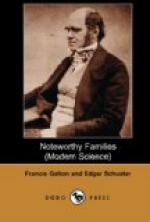The reader may work out results for himself on other hypotheses as to the percentage of noteworthiness among the generality. A considerably larger proportion would be noteworthy in the higher classes of society, but a far smaller one in the lower; it is to the bulk, say, to three-quarters of them, that the 1 per cent. estimate applies, the extreme variations from it tending to balance one another.
The figures on which the above calculations depend may each or all of them be changed to any reasonable amount, without shaking the truth of the great fact upon which Eugenics is based, that able fathers produce able children in a much larger proportion than the generality.
* * * * *
The parents of the 207 Fellows of the Royal Society occupy a wide variety of social positions. A list is given in the Appendix of the more or less noteworthy parents of those Fellows whose names occur in the list of sixty-six families. The parents are classified according to their pursuits. Many parents of the other Fellows in the 207 families were not noteworthy in the technical sense of the word, but were reported to be able. It was also often said in the replies that the general level of ability among the members of the family of the F.R.S. was high. Other parents were in no way remarkable, so the future Fellow was simply a “sport,” to use the language of horticulturists and breeders, in respect to his taste and ability. It is to be remembered that “sports” are transmissible by heredity, and have been, through careful selection, the origin of most of the valuable varieties of domesticated plants and animals. Sports have been conspicuous in the human race, especially in some individuals of the highest eminence in music, painting, and in art generally, but this is not the place to enter further into so large a subject. It has been treated at length by many writers, especially by Bateson and De Vries, also by myself in the third chapter of “Natural Inheritance” and in the preface to the second edition of “Hereditary Genius.”
NOTEWORTHY FAMILIES OF
FELLOWS OF THE ROYAL SOCIETY
LIVING IN 1904.
#AVEBURY#, Lord. See LUBBOCK.
#BALFOUR#, Right Hon. Arthur James (b. 1848), P.C.,
etc., F.R.S.,
Leader of the House of Commons,
1895; Prime Minister, 1902;
President of the British Association,
1904; author of “The
Foundations of Belief.”
[For fuller references, see “Who’s Who”
and numerous other biographies.]
bro, Francis Maitland BALFOUR (1851-1882), F.R.S., Professor of Animal Morphology at Cambridge; brilliant investigator in embryology; gold medal, Royal Society, 1881; killed by a fall in the Alps.
bro, Right Hon. Gerald W. BALFOUR (b. 1853), P.C., Fellow of Trinity College, Cambridge; President of the Board of Trade, 1902.




